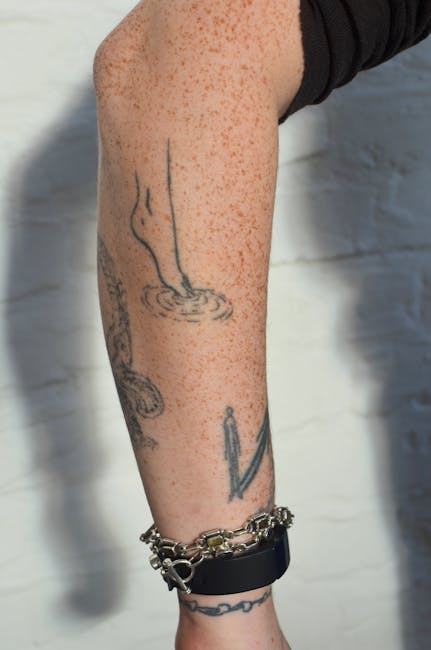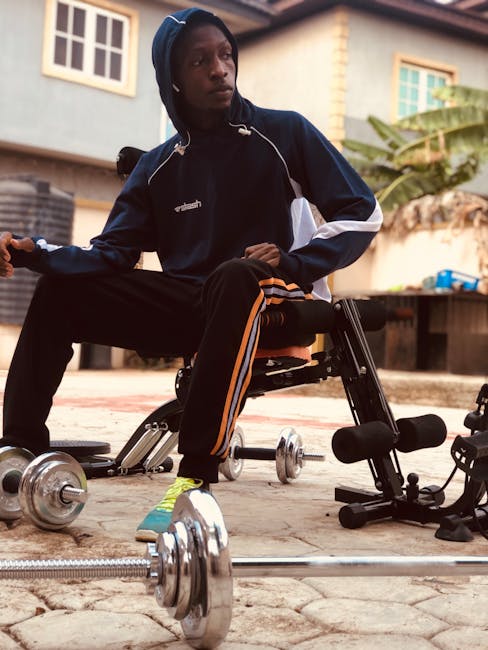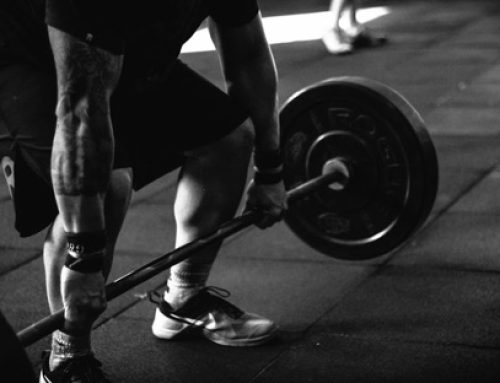Ladies and gentlemen, welcome to the “Gun Show”! And by “Gun Show”, we don’t mean Arnold Schwarzenegger flexing in his prime, we mean your own personal biceps bulging after a rigorous weightlifting session at the gym. But wait, what’s that pain in your elbow that’s making it impossible to even lift a pencil? Oh yes, it’s the infamous elbow tendonitis, the unwelcome guest that crashes every weightlifting party. But fear not, dear readers, for we are here to shed some light on the causes and treatments of this pesky condition. So grab a protein shake, sit back, and let’s dive into the world of weightlifting and elbow tendonitis.
Contents
- 1 1. Understanding Elbow Tendonitis and Its Relationship with Weightlifting
- 2 2. Common Causes of Elbow Tendonitis in Weightlifters
- 3 3. Effective Treatment Options for Weightlifters with Elbow Tendonitis
- 4 4. Prevention Strategies for Weightlifters to Avoid Tendonitis
- 5 5. Rehab Exercises for Weightlifters Returning to Training after Elbow Tendonitis
- 6 Flex those Biceps, Not your Elbows!
1. Understanding Elbow Tendonitis and Its Relationship with Weightlifting
What’s the deal with elbow tendonitis and weightlifting, amirite?
- Elbow tendonitis is a condition where the tendons in your elbow become inflamed.
- It’s a common condition among weightlifters because of the repetitive movements and stress placed on the elbow joint.
- But fear not my fellow meatheads, there are ways to prevent and treat it!
First things first, prevention is key.
- Start with a proper warm-up: Stretching and warming up before you lift can help prevent injury.
- Use proper form: Poor form and technique can put unnecessary stress on your tendons.
- Gradually increase weight: Don’t try to be a hero and lift more than you can handle. Slowly increase weight to build strength without causing injury.
If you do find yourself with elbow tendonitis, don’t panic.
- Rest and ice: Give your elbow a break and apply ice to reduce swelling.
- Stretch and strengthen: Incorporate stretching and strengthening exercises into your routine to help alleviate elbow pain.
- Consult a doctor or physical therapist: If the pain persists, seek professional help for more advanced treatment options.

2. Common Causes of Elbow Tendonitis in Weightlifters
Alright, weightlifters, listen up! If you’re feeling some nasty pain in your elbow, chances are you might have a case of tendonitis. But what the heck is that? Basically, your tendons are the tough fibers that attach your muscles to your bones. And when those suckers get irritated, inflamed or downright annoyed, you’ve got yourself a case of tendonitis.
So, what could be causing the irritation in your elbow tendons? Let’s take a look at some common culprits.
- Overuse: You’ve been hitting those weights like there’s no tomorrow, and your elbows are feeling the brunt of it. Weightlifting requires repetitive motions that can put strain on your tendons over time. No wonder your elbows are screaming at you.
- Poor form: You’re lifting with terrible form, meaning you’re putting extra stress on your tendons. If only you had listened to your gym buddy who told you to work on your technique before going heavy. Sigh, hindsight is 20/20.
- Ignoring pain: You’re one of those tough guys who just pushes through the pain. But guess what? That pain in your elbow is telling you something. If you ignore it, the tendonitis will just get worse. So be a tough guy and take a break.
So there you have it, weightlifters. Take care of your elbows, or you’ll end up looking like a T-Rex with those puny little arms. Nobody wants that.
3. Effective Treatment Options for Weightlifters with Elbow Tendonitis
Violent bouts of elbow pain are not uncommon for weightlifters. This is usually caused by a strain or tear in the tendons that connect the forearm muscles to the bone. This dreaded injury, known as elbow tendonitis, can hinder a weightlifter’s progress and cause massive gains-derailing setbacks. But fear not, for there are some effective treatment options for elbow tendonitis that will get you bench pressing and deadlifting in no time.
1. Rest and Recovery: The first step to effective treatment is rest and recovery. Give your elbows a break and avoid any movements that put extra strain on them. This may mean cutting back on your weightlifting routine for a few weeks or even months. Use ice to reduce inflammation and pain, and perform gentle stretches to maintain flexibility. You can also try wearing a supportive brace to relieve some of the pressure on your tendons.
2. Physiotherapy: Another way to treat elbow tendonitis is through physiotherapy. A skilled physiotherapist can help you develop an exercise and stretching program that will help alleviate pain and increase strength. They can also perform manual therapy, such as massage or joint mobilization, to help reduce pain and improve mobility. Additionally, your physiotherapist may use modalities like ultrasound or electrical stimulation to promote healing.
3. Medications: If rest and physiotherapy don’t provide enough relief, medication may be needed. You can take over-the-counter painkillers like aspirin or ibuprofen to reduce pain and swelling. If your pain is severe, you can ask your doctor about a prescription for stronger painkillers or even corticosteroid injections.
In conclusion, elbow tendonitis is a common and painful injury for weightlifters, but it doesn’t have to be the end of your lifting career. With the right treatment options you can get back to pumping iron in no time. Remember, rest and recovery, physiotherapy, and medication are all effective tools for battling this pesky condition. So, don’t let elbow tendonitis get you down, get back in the gym and show those weights who’s boss!
4. Prevention Strategies for Weightlifters to Avoid Tendonitis
When it comes to weightlifting, tendonitis can be a real pain in the neck – or, more accurately, in the elbow, shoulder or knee. But fear not, my fellow iron addicts, for here are some tongue-in-cheek prevention strategies that might spare you from the wrath of tendonitis.
1. Don’t listen to your body – it’s lying to you anyway. If you feel any pain or discomfort, just shrug it off and keep lifting that heavy-ass barbell. After all, no pain no gain, right? Bold move, my friend. As for me, I prefer to err on the side of caution and listen to my body when it tells me to take a break before I break something.
2. Warm-ups are overrated. Why bother with a tedious 10-minute session of mobility drills, dynamic stretches and activation exercises when you can just jump straight into the heavy lifting? Who has time for that anyway? Well, no offense, but if you don’t have 10 minutes to spare for your warm-up, you might want to reconsider your priorities. A proper warm-up can improve your performance, reduce your risk of injury and help you focus mentally. But sure, go ahead and skip it if you like living dangerously.
3. Technique is for wimps. It’s all about how much weight you can lift, right? So what if your form is sloppy and your joints are screaming for mercy? As long as you can brag about your PR on Instagram, who cares about the long-term consequences? You do, hopefully. Tendonitis can be caused by repetitive stress, overuse or improper technique, so it’s wise to invest some time and effort into learning the correct form and using it consistently. That doesn’t mean you have to sacrifice your ego or your gains, though. You can still lift heavy and lift smart, if you’re willing to learn and evolve.
5. Rehab Exercises for Weightlifters Returning to Training after Elbow Tendonitis
Are you tired of sitting on the sidelines, watching your lifting squad max out their lifts while you nurse your tender elbow? Well, fear not, my swole friends! With these rehab exercises, you’ll be back in the game in no time.
First up, we have eccentric wrist curls. Grab a light dumbbell (emphasis on light, we don’t want to aggravate that elbow) and sit on a bench with your forearm resting on a table. Slowly lower the weight down for 3-4 seconds, then use your other hand to lift it back up. Repeat for 3 sets of 10-15 reps. Your wrists will be swole, and your elbow will be thanking you for the gentle warm-up.
Next, let’s get those triceps firing with diamond push-ups. Get into a push-up position with your hands close together, forming a diamond shape with your thumbs and index fingers. Lower yourself down, keeping your elbows tucked in towards your sides, then push back up. Start with 3 sets of 5-10 reps, and increase as you gain strength.
Lastly, we have the infamous forearm plank. Get into a push-up position, then lower your forearms down to the ground. Keep your body in a straight line and hold for as long as possible. Challenge yourself by adding 5 seconds to your hold time each workout. Your core will thank you, and your elbow will be ready to tackle those heavy lifts once again.
So there you have it, folks. A few gentle rehab exercises to ease you back into lifting. Just remember: take it slow, listen to your body, and always lift with proper form. Happy lifting!
Flex those Biceps, Not your Elbows!
And there you have it! Hopefully, this article has been a helpful insight into the causes of elbow tendonitis as well as the many ways one can treat it. Remember, lifting weights is like a delicate dance with your body; you’ve got to make sure you’re doing it right, otherwise you’ll find yourself twirling straight into injury. But fear not, with the right precautions and exercises, you can become a weightlifting master without compromising your elbow health. So go ahead and flex those biceps, just make sure you’re not doing it with your elbows!








Leave A Comment